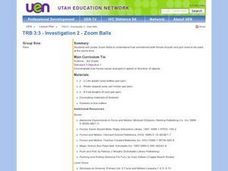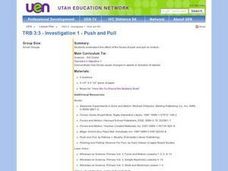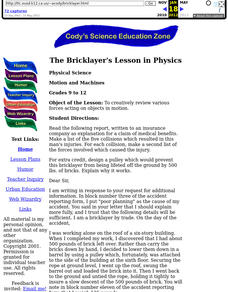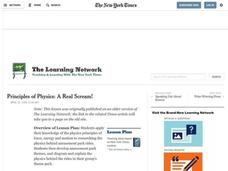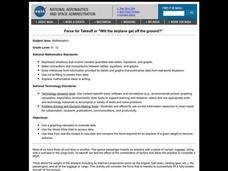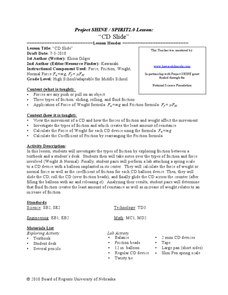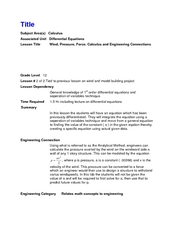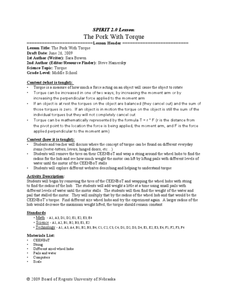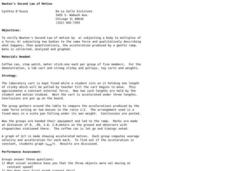Curated OER
Working in Space
Learners design and build one of three engineering problems dealing with living and working in space.
Curated OER
Working in Space
Students design and build one of three engineering problems dealing with living and working in space.
Curated OER
Extreme Acceleration
Young scholars explore the concept of acceleration. They determine the acceleration rate of a roller-blader and graph the results.
Curated OER
Forces and Motion
Fifth graders participate in a series of hands-on, Web-based activities and video-based activities to extend their learning of Forces and Motion.
Curated OER
Electric Circuits
Students model the flow of electrons in a circuit, draw diagrams of an electric circuit and build an electric circuit. Students explain how to tell when the path of an electric circuit is complete, and test the conductivity of a variety...
Curated OER
Investigation 2 - Zoom Balls
Third graders create Zoom Balls to explain how sometimes both forces of push and pull need to be used at the same time.
Curated OER
Investigation 1 - Push and Pull
Third graders study the forces of push and pull on motion
Curated OER
The Bricklayer's Lesson in Physics
High schoolers read a simulated report, written to an insurance company as explanation for a claim of medical benefits. They list the collisions that resulted in the injuries, and identify the forces involved which caused the injury.
Curated OER
Principles of Physics: A Real Scream!
Students apply their knowledge of the physics principles of force, energy and motion to researching the physics behind amusement park rides.
Curated OER
The Science of Hurricanes
Students are introduced to the science of hurricanes in an effort to highlight how forces change the speed and direction of motion.
Curated OER
Math: Will The Airplane Get Off the Ground?
Students use data from real-life models to calculate and compare the force required for an airplane of a given weight to become airborne. They use a graphing calculator to evaluate data and use the World Wide Web to access data.
Curated OER
Turbojet Thrust
Students, after reading the Web page Turbojet Thrust and completing the activity, explain how jet engines use air to produce thrust. The educational software ""FoilSim" is used in this lesson to help students calculate thrust.
Curated OER
CD Slide
Students identify the different types of friction. In this physics lesson plan, students explain how weight affects friction. They calculate normal force and coefficient of friction using a mathematical formula.
Curated OER
Wind, Pressure, Force, Calculus and Engineering Connections
Twelfth graders solve first order differential equations using the separation of variables technique. In this calculus instructional activity, 12th graders explain the connection between math and engineering. They brainstorm what...
Curated OER
The Pork With Torque
Students determine the torque of CEENBoTs wheel hub. For this physics lesson, students reinforce their learning by exploring interactive websites on torque. They give real life applications of torque.
Curated OER
Lab for Truss Design and Testing
Students design and build their own truss. For this physics lesson, students calculate the forces and maximum load. They complete a full scale diagram of their design.
Curated OER
Wind Effects on Model Building: Lab for Deflection and Moment of Inertia
Learners investigate the relationship between shape of object and moment of inertia. In this physics lesson, students collect data from the experiment and use spreadsheet to graph them. They discuss how load affects deflection.
Curated OER
Look Mom, No Wings!
Learners explain how drag, weight, lift and thrust work together to make something fly. In this physics lesson, students measure their jump height and record data on the table. They reason out why they can't remain airborne for long.
Curated OER
Using Plastics to Walk on Egg
Middle schoolers design shoes that can make them walk on eggs without breaking them. In this science lesson, students calculate pressure using force and area. They present their shoes model in class.
Curated OER
Force Counterforce
Students hypothesize what forces affect the motion of a falling body. In this physical science lesson, students create diagrams and illustrations to support their hypothesis. They perform the experiment and record observations.
Curated OER
Newton's Second Law of Motion
Sixth graders study Newton's second law of motion and verify it. In this force and motion instructional activity students complete a lab activity and collect data, analyze it and graph it.
Curated OER
Simple Harmonic Motion
Students study harmonic motion and its oscillation. In this simple harmonic motion lesson plan students demonstrate a series of regular oscillations and explain the theory behind the experiment.
Curated OER
Coulomb's Law
Ninth graders observe the relationship between electrical charge and force. In this electrical charge lesson students experiment and find the quantitative relationship between force and the center to center distance between objects.
Curated OER
The Rubber Band Problem
Students work in groups and view a rubber band demonstration. In this friction lesson students then complete the experiment themselves.







